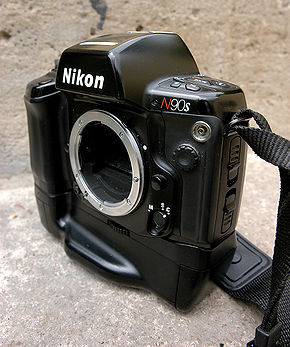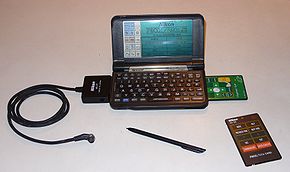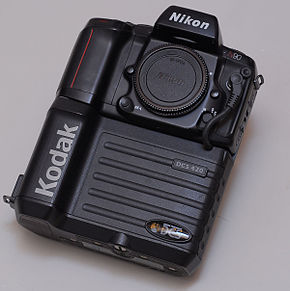- Nikon F90
-
Nikon F90X 
Type 35mm SLR Lens mount Nikon F-mount Focus TTL Phase Detection Autofocus (1 zone) Exposure PSAM autoexposure
3D Matrix MeteringFrame rate 4.3 frame/s Dimensions 154 x 106 x 69 mm, 755g The Nikon F90 (known as the N90 in the United States) is a 35mm SLR camera manufactured between 1992 and 2001 and replaced the earlier Nikon F801 (N8008 in the U.S.). At the time of its release it was noted for its fast autofocus speed compared to previous Nikon models, which had lagged behind competitor Canon's. It was thus seen by many as a 'stop-gap' measure to prevent the mass migration of many Nikon-using professional photographers to Canon, as Nikon's next fully professional camera, the F5, was some time away from release. The Nikon F4, the professional model available at the time of the F90's release, had very slow autofocus compared to Canon's autofocus SLRs.
The Nikon F90's autofocus system was driven by a small 'peanut' motor in the camera body that drove the lens via a mechanical link, unlike Canon's autofocus system, which used motors built into each lens.
Despite not being intended for the professional market, the Nikon F90 and its upgrade, the F90x, were built to a high standard and were (and are still) used by many professionals.
However, many F90 and F90x's had problems with the rubberized back, where the rubberized coating would start peeling or turn into a sticky mess.[1] The rubber around the grip and other parts were not affected. This did not affect the functionality of the back but was a nuisance to users.
The Nikon F90x (known in the United States as the N90s) was a slightly upgraded version of the very popular F90.
Differences included faster and more accurate autofocus and shutter speed adjustments in thirds of a stop versus the full-stop increments of the F90. Frame rate was also increased, along with several other minor upgrades. Weather sealing was also beefed up. In addition, it eliminated the beeping function of the F90.[2]
Contents
Accessories
Nikon N90, F90, N90s and F90s had some accessories that improve the use of this cameras
The optional MB-10 battery grip which takes 4 AA batteries and which fits on to the base of the camera was also introduced. The MB-10 added a vertical-grip shutter release and contains electronics which drain the batteries faster, but speed up auto focus and frame-rates on the F90x. Note that the MB-10 will fully work only on the F90x and N90s models. Plain N90 and F90 models will receive and mount the MB10, but the vertical shutter controls will not work as they lack the necessary electrical contacts in the battery chamber.
Along with the MF-26 data back, allowing user to change camera's configuration on demand and without using a PC, it creates a powerful set for film photography. The fully programmable MF-26 expands camera's option including multiple exposure, interval & delay mode, very long exposure times (up to 12h), continuous shooting with predefined number of frames, world time zones, flash exposure bracketing and data imprinting.
The F90(and subsequent F90x) features a 10-pin remote release socket. The MC-30 is available as a corded remote release and the ML-3 offered as a wireless option. The older MC-20 is also available.
Compatibility
The F90/x uses lenses with the Nikon F mount.
The F90 is the first camera to support 3D TTL flash metering with D lenses.[3]
Newer G lenses without aperture rings only fully function under shutter priority and program modes. It does work under manual or aperture priority, however only at the minimum aperture.[3]
Unlike the earlier F-801/s, the F90/x supports autofocus with the AF-I/AF-S series lenses with built in motors.[3]
DX lenses are not recommended as they do not cover the full 35mm frame and will lead to vignetting; however they still will function if use is desired.
Manual focus lenses will work if they are AI or AI converted, albeit with only center weighted and spot metering available. The arrows on the bottom left hand corner of the viewfinder are used to check focus. AI-P lenses, however, will enable matrix metering. non-AI lenses will damage the camera if mounted and the user should not attempt to mount these.[3]
Kodak DCS 400
In collaboration with Nikon, Kodak used F90 and F90s bodies as the basis for the Kodak DCS 400 series of digital SLRs. The DCS 410 and early DCS 420 models used the F90 (badged as N90), and the later DCS 420, DCS 460, and NC2000 used the F90x (badged N90s). The cameras were mounted, with minor modifications, on a Kodak digital back.
External links
References
- ^ [1], Ken Rockwell on rubber back issue
- ^ [2], F90 vs F90x differences
- ^ a b c d [3], Lens compatibility reference.
Nikon 35mm Film SLR Cameras Manual Focus Autofocus Categories:- Nikon SLR cameras
Wikimedia Foundation. 2010.



